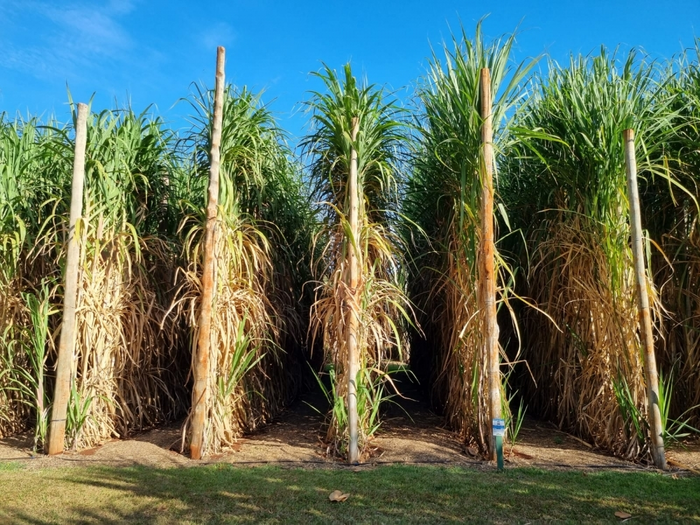A study conducted at the State University of Campinas (UNICAMP) in Brazil identified orphan genes in Wild sugarcane, Saccharum spontaneum, a species with exceptional resistance to biotic stresses such as nematodes, fungi, bacteria and other pests and diseases, and abiotic stresses such as cold, drought, salinity and nutritionally deficient soil.

Credit: Luciana Rossini/IAC, Sugarcane Center, Ribeirão Preto
A study conducted at the State University of Campinas (UNICAMP) in Brazil identified orphan genes in Wild sugarcane, Saccharum spontaneum, a species with exceptional resistance to biotic stresses such as nematodes, fungi, bacteria and other pests and diseases, and abiotic stresses such as cold, drought, salinity and nutritionally deficient soil.
According to an article on the study published in the journal Frontiers in Plant Science, the scientists responsible set out to see if the orphan genes in S. spontaneum played a significant role in its stress resistance properties.
All living beings have genes that closely resemble those of other organisms’ genomes. Plants, for example, share the genes involved in photosynthesis. On the other hand, most organisms also have orphan or lineage-specific genes.
Orphan genes are genes found in a particular taxonomic group with no significant sequence similarity to genes from other lineages. They are sometimes called taxonomically restricted genes for this reason.
Birds, for example, have some genes that differ a great deal from those of mammals. Recent research has shown that even organisms in closely related species belonging to the same genus can have genes not shared by other species.
The researchers were interested in S. spontaneum because of characteristics such as past whole-genome duplication events that resulted in several copies of the same gene. Scientific evidence suggests orphan genes can originate in copies of pre-existing genes whose sequences change over time owing to mutations and eventually differ entirely from the original sequences.
Another possible explanation for the origin of orphan genes could be reorganization of genomic regions that do not encode genes, frequently seen in organisms with complex genomes, such as sugarcane.
“In the study, we identified parts of the genome of S. spontaneum that have no similarities to genes in any other organism. We believe they may be responsible for physiological traits or properties peculiar to the species,” said Cláudio Benício Cardoso-Silva, first author of the article. He conducted the project as postdoctoral research at UNICAMP’s Center for Molecular Biology and Genetic Engineering (CBMEG), with FAPESP’s support.
“As these plants evolved, some genes were expressed to a greater or lesser extent in response to various types of abiotic stress, particularly cold. This may mean they’re regulated as a result of these stresses,” said Cardoso-Silva, whose postdoctoral research was supervised by Anete Pereira de Souza, professor of plant genetics at UNICAMP’s Institute of Biology and last author of the article.
The researchers do not believe they can categorically conclude that the orphan genes they identified make the plant more stress-tolerant based on the results of the study. “But the fact that they’re regulated under conditions of stress serves as an alert to the possibility that they may play an important role in these processes,” he said.
The next step will be to experiment on plants submitted to various kinds of stress in order to investigate how orphan genes behave in terms of expression, compared to non-stressed plants. Once the best candidate genes are confirmed, biotech applications involving their insertion into commercially valuable plants can be studied, leading in future to the possibility of developing sugarcane varieties more resistant to environmental pressures.
“We shone a spotlight on this possibility for anyone who wants to use the data in the article to continue the research, or for scientists who work with gene transformation and editing, which is a different research field, to choose one or two genes as candidates and do the validation,” said Cardoso-Silva, who continues to work with genomics at the State University of Northern Rio de Janeiro (UENF). “My current research focuses on the evolutionary aspect of gene family expansion,” he explained.
Cardoso-Silva spent a year at the University of British Columbia in Vancouver, Canada, with a fellowship from FAPESP.
“Today we have CRISPR [the gene editing technique], which offers biotech professionals a chance to select genes for tolerance of drought, salinity, cold or heat at a time when crop resilience with fewer inputs is paramount,” Souza said.
About São Paulo Research Foundation (FAPESP)
The São Paulo Research Foundation (FAPESP) is a public institution with the mission of supporting scientific research in all fields of knowledge by awarding scholarships, fellowships and grants to investigators linked with higher education and research institutions in the State of São Paulo, Brazil. FAPESP is aware that the very best research can only be done by working with the best researchers internationally. Therefore, it has established partnerships with funding agencies, higher education, private companies, and research organizations in other countries known for the quality of their research and has been encouraging scientists funded by its grants to further develop their international collaboration. You can learn more about FAPESP at www.fapesp.br/en and visit FAPESP news agency at www.agencia.fapesp.br/en to keep updated with the latest scientific breakthroughs FAPESP helps achieve through its many programs, awards and research centers. You may also subscribe to FAPESP news agency at http://agencia.fapesp.br/subscribe
Journal
Frontiers in Plant Science
DOI
10.3389/fpls.2022.923069
Article Title
Taxonomically Restricted Genes Are Associated With Responses to Biotic and Abiotic Stresses in Sugarcane (Saccharum spp.)
Article Publication Date
30-Jun-2022




